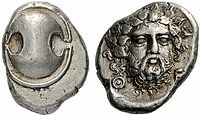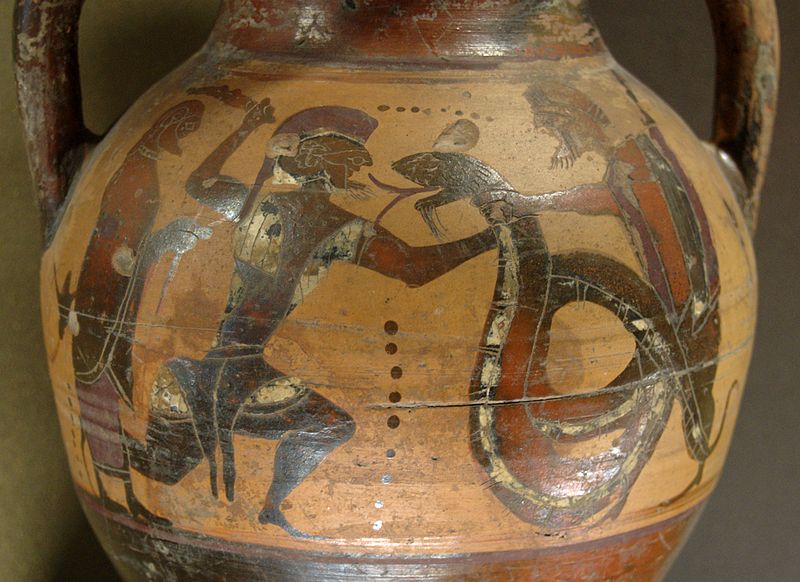DESCRIPTION
The Thebes Archaeological Museum is one of Greece's most important museums because of its rare and even unique collections. The exhibits come from excavations in Boiotia and cover the region's civilization from the Paleolithic to the Post-Byzantine periods.
The museum's ground-floor building with its large courtyard, is located at the north end of the Kadmeion hill. Its permanent collection is displayed in four large exhibition halls, the lobby and the courtyard. The museum also houses conservation laboratories, storage rooms and the offices of the Ninth Ephorate of Prehistoric and Classical Antiquities, which oversees the museum. A characteristic constituent of the museum is the Medieval tower in the courtyard, a remainder of the Frankish fortification of Thebes, which is currently a storeroom. It is believed to be part of the castle that was built by Nicholas II de Saint-Omer, the Archon of Thebes in 1278. Tradition has it that the north gate of the city's ancient fortifications stood at this same spot.
The museum's current work includes the cataloguing and identification of old archaeological discoveries based on the inventory catalogues, the establishment of a database and of a photographic archive of the finds, their cleaning and conservation, and finally the preparations for the construction of a new museum. Several of the Ninth Ephorate's activities, such as public lectures, educational programs and other cultural expositions, take place on the museum's premises.
HISTORY
A small collection of artefacts grew out of the very fruitful archaeological research in Boiotia at the beginning of the twentieth century. Antonios Keramopoullos founded the Archaeological Museum in 1905. It was housed in a two-storey building, which was specially built on the projection at the north end of the historic acropolis of the Kadmeion. Apart from the sculptures of Thespiai and Ptoo and other surface finds from Boiotia, the museum displayed the finds from Keramopoullos' investigations in the palace of Kadmos, those from the Polyandrion at Thespiai, and many more from the Mycenaean and Classical cemeteries of Thebes, Tanagra and Ritsona, and from the prehistoric settlement of Eutresis.
The old replete museum was replaced by a new one built on the same location. This new museum, the life's work of the then Ephor of Antiquities, I. Threpsiadis, was inaugurated in 1962 and housed many new finds, particularly those from the sanctuary of Artemis at Aulis. During the 1960's the collection was enriched by finds from the important excavations at the Kadmeion, by several representative objects from the German excavations at Kabireion and from the excavations at Thebes, Orchomenos and Tanagra, which were conducted by the Ninth Ephorate of Prehistoric and Classical Antiquities. During this same decade the museum's garden was used for the first time to display antiquities, while the finds from the Mycenaean cemetery at Tanagra were exhibited in a special room which opened to the public in 1972.
The spectacular archaeological discoveries in the centre of the Kadmeion on the Mycenaean and Classical acropolis of Thebes, the extensive cemeteries of Akraiphnion, the many rescue excavations and random finds in settlements, cemeteries and sanctuaries in Boiotia and in the Larymna region, increased the number of finds and made the construction of a new museum building at the west of the promontory necessary. At the same time a much-needed parking area was created east of Keramopoullos Square and the Medieval tower.
EXHIBITIONS
The permanent exhibition of the Thebes Archaeological Museum comprises characteristic finds from Greek and foreign excavations conducted in Boiotia, which span the long chronological period from the Paleolithic to the Post-byzantine periods. Some of its collections are especially interesting because they are unique; for example the Near Eastern Bronze Age cylinder seals from the Theban palace in the Kadmeion, the Mycenaean larnakes from Tanagra, the Archaic kouroi from Ptoon and the characteristic black stone Classical funerary stelai.
The exhibition, which occupies large rooms, the lobby and the museum's garden, is organized by time period and by artifact type and also finds from recent excavations .In a separated room are displayed the Byzantine antiquities of Boiotia.


Source : http://odysseus.culture.gr/h/1/eh151.jsp?obj_id=3372
Authors: Vasileios Aravantinos , Elena Vlachogianni, archaeologists
More information:
http://www.latsis-foundation.org/eng/electronic-library/the-museum-cycle/the-archaeological-museum-of-thebes